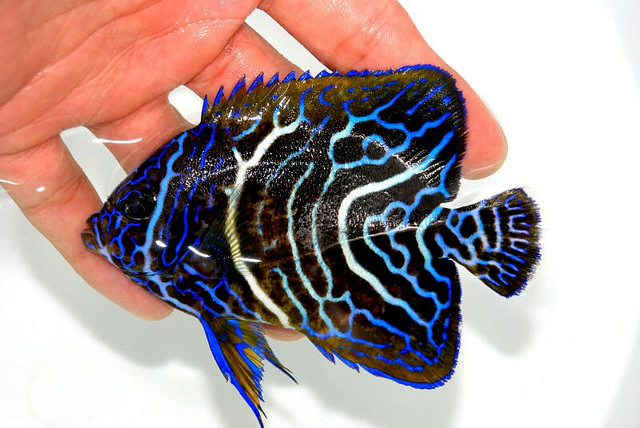If you’re a fan of the Pokémon franchise and the anime, then you should be familiar with the post advertisement segment called “Who’s that Pokémon?!” egging viewers to guess the identity of the pokémon based on its silhouette. Obviously the answer would be the pokémon centred around that series episode (duh), but for a show intended for ten year olds (and me, big fan) it’s understandable. Well for the grown up fish people it’s a little different, and less easy. Today on “Who’s that Pomacanthus?!” we feature a possible hybrid that well, is open to your ideas. So like the inner ten year old that you all are, sitting on that couch watching pokémon on a Saturday morning, put on your thinking caps and start guessing.
So what we’re going to do is to present the background information on this fish, and then you start guessing. Post your opinion on what you think it is in the comments here, or on our Facebook page. The picture above shows a juvenile Pomacanthus hybrid belonging to Mr. Stanley Shen. It was collected in North-East Taiwan. Although Mr. Shen is in contact with various marine biologist at the local institute capable of performing DNA analysis, he prefers watching the fish grow and guessing its identity as it matures. The juvenile above was photographed 10 months ago, around October 2013.

What’s great is that Mr. Shen has a photographic documentation of its development from day one of acquisition up till now. This photo above shows the same fish, a few months after purchase.

As the fish grew and started changing out of its juvenile coloration, Mr. Shen would periodically photograph it for his records. The picture immediately above shows the same fish photographed approximately five months ago, around June-July.

This picture above shows the current fish today. Now it is pretty clear in identifying at least one of the parents. What’s tricky is guessing genetic input from the other. Now hybrids aren’t always as easy as A and B. Some are fertile and are capable of back-crossing with one of its parent species, or even with another forming a tri-brid. Some only develop more prominent characteristics of the other parent later on in its life.
For those wondering, the species found locally in the area are Pomacanthus semicirculatus, P. imperator, P. xanthometopon, P. narvachus, P. annularis and P. sextriatus (which is locally rather abundant). Based on the following species, who do you think is most likely to be involved in this fish? We have our own opinions on this, but we’d like to hear yours! Let us know in the comments below or on our Facebook page!



